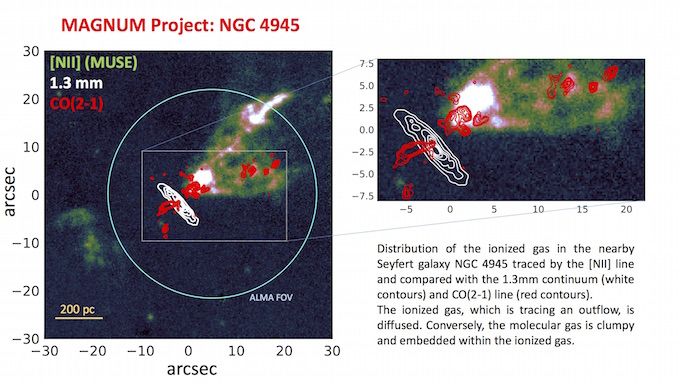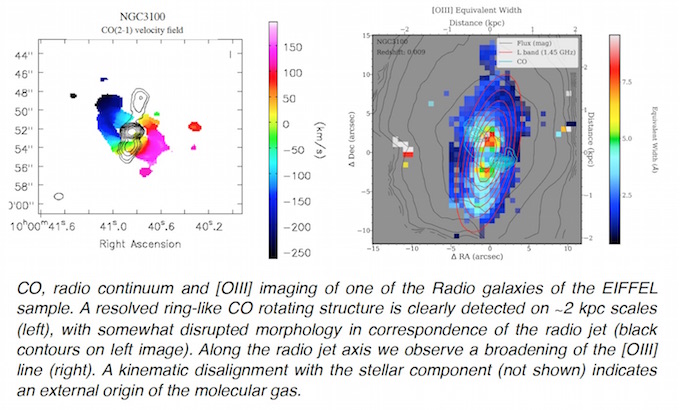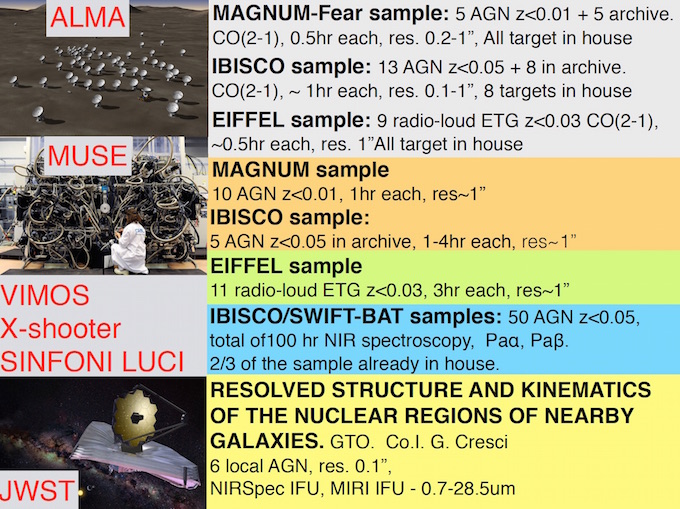WP3 is bases on data from the programs shown below
Task3.1 Magnum sample [Lead: UniFI, participants: INAF]
This sample includes all known local AGN closer than 50 Mpc and with log(Lbol) =43-44.
Task3.2 IBISCO sample [Lead: INAF, participants: UniFI]
This sample includes local, hard X-ray selected (INTEGRAL/IBIS) AGN with log(Lbol)=43-45.3, thus partly overlapping with the SUPER sample.
The proximity of the MAGNUM and IBISCO samples allows the investigation of physical scales (~20-100pc) hardly accessible at high-z. For both samples we will map with ALMA and NOEMA the molecular gas kinematics. Rotation will be modeled in the Fourier plane and subtracted, so to highlight non-circular motion including molecular winds[37]. With MUSE we will map the kinematics of the ionized gas ([OIII] line, broad H and H lines), and SF (narrow Ha, Hb lines, [OII]). We will compare low and high velocity maps of molecular and ionized gas, to find whether ionized and molecular disk and winds are co-spatial and assess their clumpiness.
The figure shows an example of the power of ALMA and MUSE in mapping the multiphase gas in local galaxies.

JWST will allow a more detailed and complete mapping of ionized, neutral and warm molecular gas, thanks to the exquisite spatial resolution over a broad band (0.7-27um). All these observations will guide interpretation of data of coarser resolution data (WP1, 2) and models (WP4).
Task3.3 The other side of BH accretion: the EIFFEL local radio galaxy sample [Lead: INAF, Participants: UniBo]
We will study the kinematics of stars, ionized, and cold gas in the cores of a volume-limited sample of 11 local radio-loud early type galaxies (ETG). We will identify kinematical signatures of feeding/feedback loops that can be related to the presence of radio jets. The comparison with radio-quiet ETGs (e.g. ATLAS3D [38]), will allow us to isolate the role played by jet feedback in the formation and evolution of ETGs.
For all sources we have obtained VLT/VIMOS IFS observations and CO(2-1) integrated spectra with APEX [39], and for 9 sources CO(2-1) mapping with ALMA. VLA sub-arcsec radio imaging is scheduled for 2018. This dataset will provide accurate radio-jet modeling, a comprehensive description of the spatially-resolved stellar and ionized gas kinematics, and will allow us to resolve the molecular gas component on scales of 100–300 pc. An illustration of the multiwavelength analysis enabled by the EIFFEL sample is shown in the Figure.

Task3.4 Local AGN physical quantities [Lead: RomaTRE, participants: INAF, UniFi, UniBo]
We will measure BH masses and the accreting host galaxy properties (Lbol, SFR, M*) of an unbiased (flux limited) sample of 50 local hard-X ray selected AGN, using deep NIR spectroscopy, building on our successful pilot program[40,41,42]. We will measure for the first time the local BH mass function, AGN BH-mass/bulge scaling relations and the accretion/SF properties of local AGN, to be compared with high-z samples (WP1,2) and to guide models (WP4).
Task3.5 BH winds in luminous nearby QSO: the SUBWAYS sample of PG quasars [Lead: UniBo]
This task will exploit data from the SUBWAYS project (“Supermassive Black Holes Winds in the X-rays”), an ongoing (AO18) XMM-Newton Large Program aimed at detecting X-ray winds in a sample of ~20 quasars at z~0.2.

